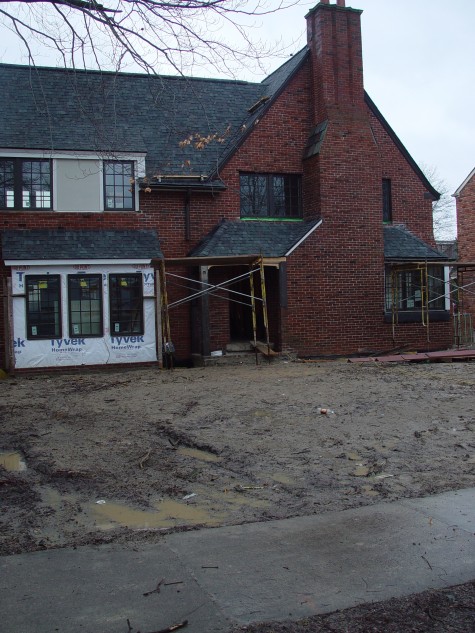 This lovely home in a local neighborhood was in sore need of updating, and needed additional space to house a young family with children. The addition was in progress the first time I saw the house. On this miserably wet and cold March day, the prospects for the outdoors did not look promising. Contractors had driven machines over every inch of land they owned. Water was sitting on the surface of the soil everywhere. It seemed like every move my clients made uncovered a new problem requiring attention. When a house is under major renovation, the landscape is last in line-as it needs to be.
This lovely home in a local neighborhood was in sore need of updating, and needed additional space to house a young family with children. The addition was in progress the first time I saw the house. On this miserably wet and cold March day, the prospects for the outdoors did not look promising. Contractors had driven machines over every inch of land they owned. Water was sitting on the surface of the soil everywhere. It seemed like every move my clients made uncovered a new problem requiring attention. When a house is under major renovation, the landscape is last in line-as it needs to be.
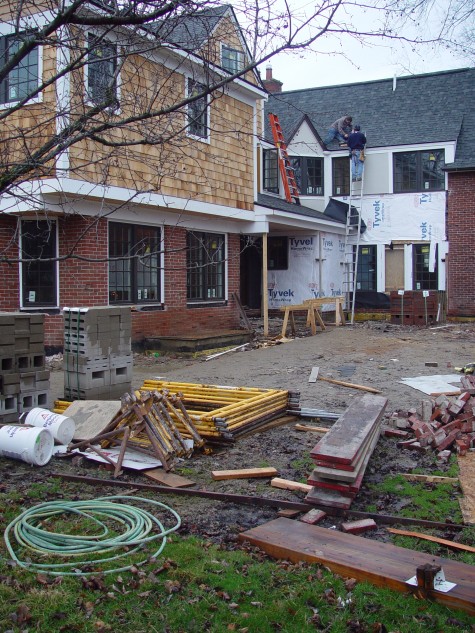 It wouldn’t be possible to install a landscape at this point. Some years ago the New York Times ran a feature about landscape costs-the thrust of which was that it can, and frequently does take as much money to build and furnish a landscape as a house. I don’t know that I would go that far, but a landscape is a considerable investment. Though property values have been under siege in our area of late, it is still true that for most people, their home will be the biggest investment they ever make-for better, or for worse. Thus I have no problem recommending to a young family that they invest such that fifteen years later, should they decide to move, a landscape that is in place will make that home they want to sell look settled, finished- irresistible.
It wouldn’t be possible to install a landscape at this point. Some years ago the New York Times ran a feature about landscape costs-the thrust of which was that it can, and frequently does take as much money to build and furnish a landscape as a house. I don’t know that I would go that far, but a landscape is a considerable investment. Though property values have been under siege in our area of late, it is still true that for most people, their home will be the biggest investment they ever make-for better, or for worse. Thus I have no problem recommending to a young family that they invest such that fifteen years later, should they decide to move, a landscape that is in place will make that home they want to sell look settled, finished- irresistible.
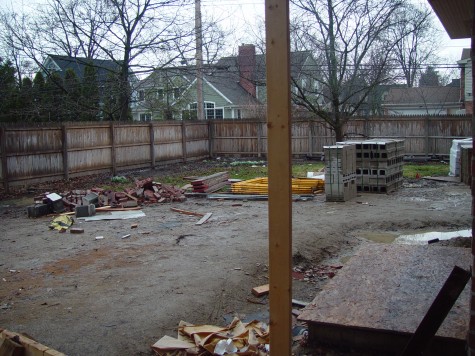 Some very important investments in a landscape are not fun. This property was the lowest property in the neighborhood, and water would stand and not drain for weeks after a heavy rain. The regrading and drainage work necessary to correct this problem was very expensive, and not so satisfying. It was about as much fun as buying a new hot water heater. I have seen many landscapes, installed both by home owners, and professional landscape contractors, where drainage issues were not addressed. The plant material is struggling, dying or dead from the lack of an investment in the drainage. For the sake of the future, some things cannot be skipped over.
Some very important investments in a landscape are not fun. This property was the lowest property in the neighborhood, and water would stand and not drain for weeks after a heavy rain. The regrading and drainage work necessary to correct this problem was very expensive, and not so satisfying. It was about as much fun as buying a new hot water heater. I have seen many landscapes, installed both by home owners, and professional landscape contractors, where drainage issues were not addressed. The plant material is struggling, dying or dead from the lack of an investment in the drainage. For the sake of the future, some things cannot be skipped over.
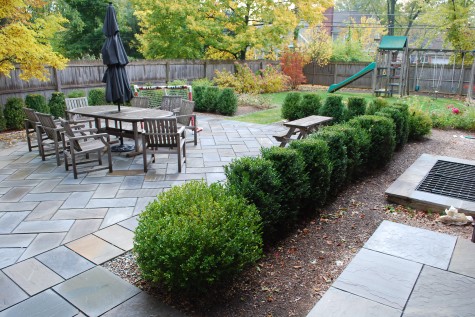 These clients knew they wanted stone for their terrace and walkways. Bluestone is a gorgeous natural stone that gives a space a solid and serious look. They also wanted their stone wet set in mortar. Mortaring stone to a concrete substrate insures a level surface that presumably does not move, or require maintenance. I say this with one caveat; the winters in Michigan will heave up just about anything. I made sure the installation was expert.
These clients knew they wanted stone for their terrace and walkways. Bluestone is a gorgeous natural stone that gives a space a solid and serious look. They also wanted their stone wet set in mortar. Mortaring stone to a concrete substrate insures a level surface that presumably does not move, or require maintenance. I say this with one caveat; the winters in Michigan will heave up just about anything. I made sure the installation was expert.
 Their decision was to stage the installation of the landscape such that they could have their mortared stone. The first year, their yard consisted of stone, and lawn. Year two saw the boxwood installed in the rear, and the yews in the front. This year, some of the garden. Next year, the yews designed to back up the boxwood here, and maybe an arbor. I do admire their willingness to wait, in order to have the landscape they wanted. Get a plan, pick a part to install you can handle, do it, and proceed again when time and money permits. This seems like such a logical and good way to proceed.
Their decision was to stage the installation of the landscape such that they could have their mortared stone. The first year, their yard consisted of stone, and lawn. Year two saw the boxwood installed in the rear, and the yews in the front. This year, some of the garden. Next year, the yews designed to back up the boxwood here, and maybe an arbor. I do admire their willingness to wait, in order to have the landscape they wanted. Get a plan, pick a part to install you can handle, do it, and proceed again when time and money permits. This seems like such a logical and good way to proceed.
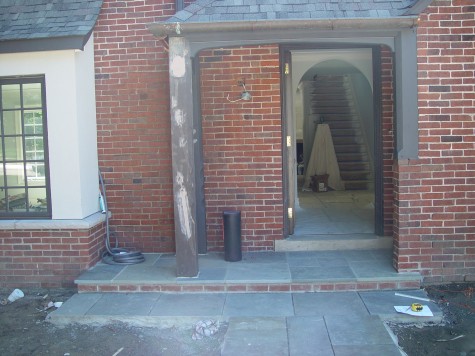 The front porch, originally only inches wider than the front door, was redone. The new porch absorbed an awkward space between the original stoop, and the adjacent bay window. Four years later, with the exception of one stone that is shaling probably from salt damage, the stonework is beautifully intact.
The front porch, originally only inches wider than the front door, was redone. The new porch absorbed an awkward space between the original stoop, and the adjacent bay window. Four years later, with the exception of one stone that is shaling probably from salt damage, the stonework is beautifully intact.
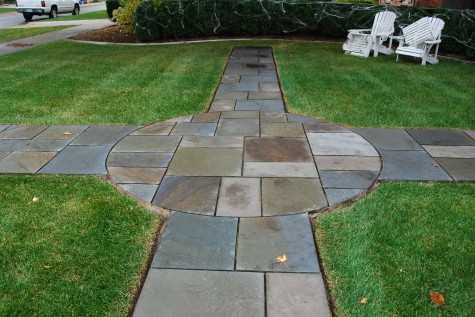 The front walkways from the drive and streetside meet in a circular stone landing midway to the door. Perhaps there will be a sundial someday, or a sculpture, or a high school graduation picture being taken.
The front walkways from the drive and streetside meet in a circular stone landing midway to the door. Perhaps there will be a sundial someday, or a sculpture, or a high school graduation picture being taken.
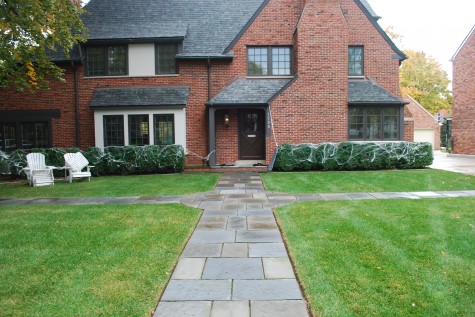
The landscape in front does indeed have a spare look, but it is a very elegant look. They are taking their time. When they are ready for the next step, perhaps a new, and better idea will surface. Everything about this project is forward thinking.
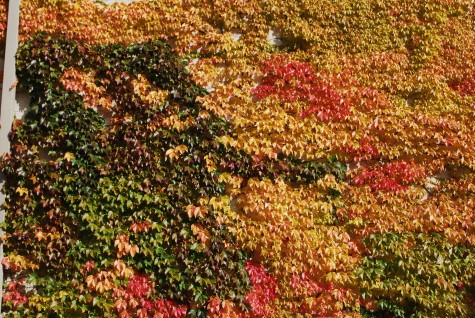 I have never forgotten my ninth grade science teacher, Dr. Watson. He concluded every lecture or discussion with the statement, “And that is the beauty of science”. Though at the time I thought he was a crackpot, I now know he was absolutely right. Today I am thinking about Parthenocissus Tricuspidata; Boston Ivy is an ordinary plant with a fancy scientific name whose primary claim to fame is its ability to grip to and cover walls with dense sheets of leaves. Why today? The fall color of Boston Ivy is one of nature’s most spectacularly glowing moments, ranking right up there with the aurora borealis.
I have never forgotten my ninth grade science teacher, Dr. Watson. He concluded every lecture or discussion with the statement, “And that is the beauty of science”. Though at the time I thought he was a crackpot, I now know he was absolutely right. Today I am thinking about Parthenocissus Tricuspidata; Boston Ivy is an ordinary plant with a fancy scientific name whose primary claim to fame is its ability to grip to and cover walls with dense sheets of leaves. Why today? The fall color of Boston Ivy is one of nature’s most spectacularly glowing moments, ranking right up there with the aurora borealis. 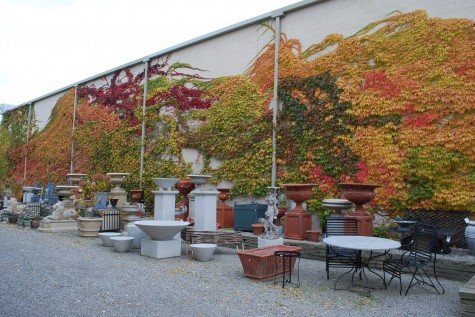 One wall of the building next door to me sits right on my property line; that would be just about two thousand square feet of beige concrete block. Needless to say, I was not too crazy about the look. Five Boston Ivy plants have just about transformed that wall in four years time; today it is looking exceptionally good. The science behind all this color-the formation of the abcission layer. Don’t black out; I’m talking about the beauty of science here. As soon as the nights get long enough in the fall, the cells that connect the leaves to the stems begin to rapidly divide-but they do not expand. This produces a brittle callus, which slows, and finally prevents the flow of nutrients from the stem to the leaves. The plant is going dormant, and putting any expenditure of energy on hold. This is a survival mechanism, the instinct to preserve life, and the beauty of science.
One wall of the building next door to me sits right on my property line; that would be just about two thousand square feet of beige concrete block. Needless to say, I was not too crazy about the look. Five Boston Ivy plants have just about transformed that wall in four years time; today it is looking exceptionally good. The science behind all this color-the formation of the abcission layer. Don’t black out; I’m talking about the beauty of science here. As soon as the nights get long enough in the fall, the cells that connect the leaves to the stems begin to rapidly divide-but they do not expand. This produces a brittle callus, which slows, and finally prevents the flow of nutrients from the stem to the leaves. The plant is going dormant, and putting any expenditure of energy on hold. This is a survival mechanism, the instinct to preserve life, and the beauty of science. 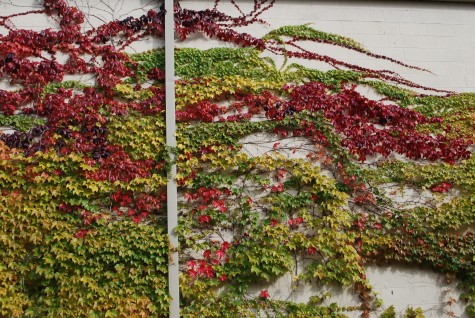 At the same time, the leaves slow down and eventually quit producing chlorophyll-that chemical that makes leaves green. If chlorophyll is not constantly manufactured in a leaf, the leaf will fade in sunlight. Chlorophyll masks the other pigments existing in leaves; the yellows, oranges and reds that were there all along are revealed when the production of chlorophyll ceases.
At the same time, the leaves slow down and eventually quit producing chlorophyll-that chemical that makes leaves green. If chlorophyll is not constantly manufactured in a leaf, the leaf will fade in sunlight. Chlorophyll masks the other pigments existing in leaves; the yellows, oranges and reds that were there all along are revealed when the production of chlorophyll ceases. 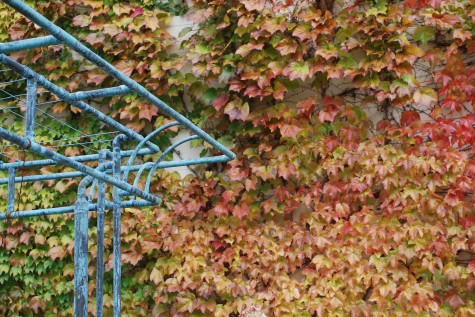 Though day length triggers this process, the temperatures, the moisture in the soil, and sunlight influence the overall show. A dry growing season can encourage leaves to drop early before they reveal any color. High winds can sever the dry corky abscission layer with the same result. At any rate, the variation and intensity of color on this wall is different every year given weather conditions. I can see that light, water, wind, sun and overnight temperatures affect the leaves on wall at different rates.
Though day length triggers this process, the temperatures, the moisture in the soil, and sunlight influence the overall show. A dry growing season can encourage leaves to drop early before they reveal any color. High winds can sever the dry corky abscission layer with the same result. At any rate, the variation and intensity of color on this wall is different every year given weather conditions. I can see that light, water, wind, sun and overnight temperatures affect the leaves on wall at different rates.  It is easy to see the chlorophyll fading at different rates in different leaves-the color variation within each individual leaf is beautiful.
It is easy to see the chlorophyll fading at different rates in different leaves-the color variation within each individual leaf is beautiful.  Anthocyanins are responsible for the red and purple pigments in leaves. They are manufactured from sugars that are trapped in the leaf. Oddly enough, these pigments are not present in leaves during the growing season. The role of these pigments is not so well understood. If you are interested in reading more about it, The United States National Arboretum has an excellent article on line about the science of color in autumn leaves.
Anthocyanins are responsible for the red and purple pigments in leaves. They are manufactured from sugars that are trapped in the leaf. Oddly enough, these pigments are not present in leaves during the growing season. The role of these pigments is not so well understood. If you are interested in reading more about it, The United States National Arboretum has an excellent article on line about the science of color in autumn leaves. Metasequoia Glyptostroboides-I wish this were my name. The Dawn Redwood is an ancient evergreen tree with a twist; it drops its needles in the fall, after turning this glorious peachy orange. This deciduous evergreen is an anomaly amongst evergreens, which ordinarily hold their foliage all winter.
Metasequoia Glyptostroboides-I wish this were my name. The Dawn Redwood is an ancient evergreen tree with a twist; it drops its needles in the fall, after turning this glorious peachy orange. This deciduous evergreen is an anomaly amongst evergreens, which ordinarily hold their foliage all winter. 
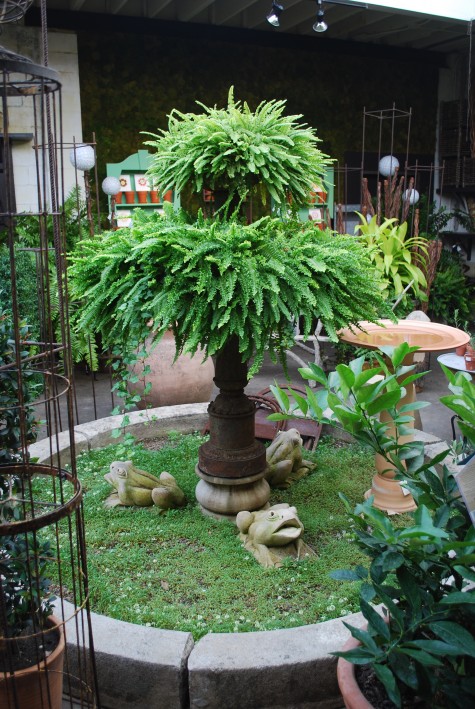 As fond as I am of ferns for shady spots in a perennial garden, there are plenty of tropical species too handsome to pass up. I have a client whose pair of Australian tree ferns flank her front door every summer; they have spent the winter in the greenhouse for the past six years. On a smaller scale, Victorian parlor ferns and Boston ferns prosper in a shady spot outdoors over the summer, and make a decent show in a cool light place indoors over the winter. Every fall we fall heir to a number of plants clients have no place for, but can’t bear to compost. Won’t we take them? Try as I can, I can’t say no to a plant in need of a home. Added to these were a number of ferns Rob grew in pots at home this year. As the dwarf crested ferns we planted 2 years ago in this antique French fountain are clearly very happy, Rob decided a fernery was in order.
As fond as I am of ferns for shady spots in a perennial garden, there are plenty of tropical species too handsome to pass up. I have a client whose pair of Australian tree ferns flank her front door every summer; they have spent the winter in the greenhouse for the past six years. On a smaller scale, Victorian parlor ferns and Boston ferns prosper in a shady spot outdoors over the summer, and make a decent show in a cool light place indoors over the winter. Every fall we fall heir to a number of plants clients have no place for, but can’t bear to compost. Won’t we take them? Try as I can, I can’t say no to a plant in need of a home. Added to these were a number of ferns Rob grew in pots at home this year. As the dwarf crested ferns we planted 2 years ago in this antique French fountain are clearly very happy, Rob decided a fernery was in order.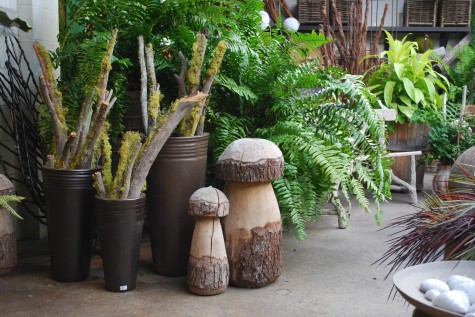 Once Rob gets a theme going, he has a sure hand putting a vignette together. The fern collection is kept company with lichen encrusted sticks from Oregon and carved wood mushrooms from Belgium. The giant fronds of what we call Macho ferns from his yard arch out some 30 inches, and cascade gracefully to the floor. We have turned on our heat, but an industrial building from the 1940’s heated with old Modine greenhouse furnaces stays decidedly cool.
Once Rob gets a theme going, he has a sure hand putting a vignette together. The fern collection is kept company with lichen encrusted sticks from Oregon and carved wood mushrooms from Belgium. The giant fronds of what we call Macho ferns from his yard arch out some 30 inches, and cascade gracefully to the floor. We have turned on our heat, but an industrial building from the 1940’s heated with old Modine greenhouse furnaces stays decidedly cool. A chartreuse dracaena named “Janet Craig” that grew vigorously over the summer in an oak barrel is brought inside. Its fountain like habit of growth is fern like, but the texture much more simple and dramatic. I find shade loving tropicals are indispensible for growing shade containers that are fresh and lively-different than the usual. This plant will winter well here; it will make a fine centerpiece for a shade pot next summer.
A chartreuse dracaena named “Janet Craig” that grew vigorously over the summer in an oak barrel is brought inside. Its fountain like habit of growth is fern like, but the texture much more simple and dramatic. I find shade loving tropicals are indispensible for growing shade containers that are fresh and lively-different than the usual. This plant will winter well here; it will make a fine centerpiece for a shade pot next summer.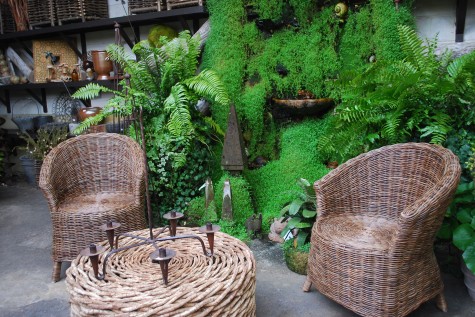 A pair of woven wood chairs and a table are drawn up to the fountain wall covered in baby tears. The elements of water and moss add to the woodsy look of a fern room. I cut a hole in the ceiling here large enough to handle the roof of an old Lord and Burham greenhouse. A shop devoted to all things garden would seem lacking without water, and a space to grow plants.
A pair of woven wood chairs and a table are drawn up to the fountain wall covered in baby tears. The elements of water and moss add to the woodsy look of a fern room. I cut a hole in the ceiling here large enough to handle the roof of an old Lord and Burham greenhouse. A shop devoted to all things garden would seem lacking without water, and a space to grow plants. As the room starts to fill up with plants, the space begins to feel like a conservatory. It is no wonder people go to great trouble and expense to have glass houses, or grow lights in the basement. I perfectly understand that feeling of being shut in, once I am shut out of the garden. These ferns make me think about having plants at home over the winter.
As the room starts to fill up with plants, the space begins to feel like a conservatory. It is no wonder people go to great trouble and expense to have glass houses, or grow lights in the basement. I perfectly understand that feeling of being shut in, once I am shut out of the garden. These ferns make me think about having plants at home over the winter. 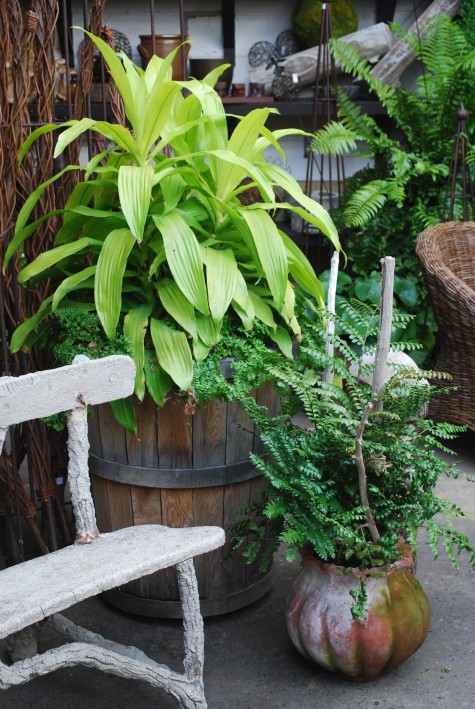
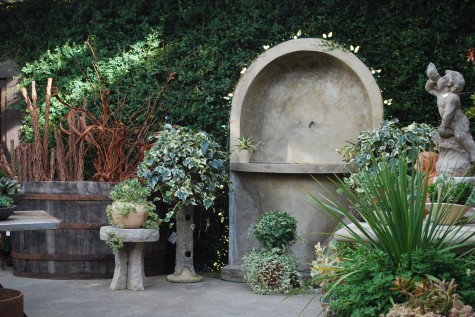 We find a home for the other bits as well. A pair of variegated Algerian ivies are so striking in a pair of old faux bois planters. A spike encircled with Cuban oregano organizes a collection of small agaves and echeverias; Rob is calling this the arid zone. An old varigated ivy single ball topiary in need of a haircut will get a winter home somewhere in this room. The climbing fig that covers the walls completes the green picture.
We find a home for the other bits as well. A pair of variegated Algerian ivies are so striking in a pair of old faux bois planters. A spike encircled with Cuban oregano organizes a collection of small agaves and echeverias; Rob is calling this the arid zone. An old varigated ivy single ball topiary in need of a haircut will get a winter home somewhere in this room. The climbing fig that covers the walls completes the green picture. 